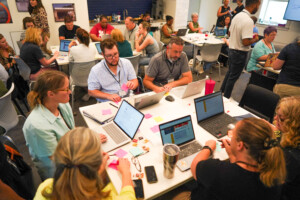Pilots Offer a Promising Path to Competency-Based Education

By Karla Phillips and Carri Schneider
This post originally published on EducationNext
Our nation’s traditional, time-based education system advances students based primarily on their age, regardless of their depth of understanding.
By not ensuring mastery, the current system pushes students forward who are not yet ready, leaving them with gaps in critical knowledge or fundamental skills that must be remedied later. At the same time, the traditional system often prevents students from engaging more deeply in their interests, excelling when they are ready, or pursuing additional academic challenges.
Over time, this outdated education system repeatedly fails far too many students. A different approach gaining interest is competency-based education (CBE), a system where students advance to higher levels of learning when they demonstrate mastery of concepts and skills regardless of time, place, or pace. (Note: The terms competency, proficiency and mastery are often used interchangeably.)
While a shift toward competency-based education can begin at the school-level, state policies can either help or hinder successful implementation. As a result, a shift to competency-based education can seem prohibitively complex at the outset. Competency-based education pilot programs provide a reasonable and actionable first step for state policymakers seeking to advance competency-based education.
Policy, Pilots and the Path to Competency-Based Education: A Tale of Three States, produced by ExcelinEd in partnership with Getting Smart, describes how Idaho, Utah and Florida launched competency-based education pilot programs. Mirroring the flexibility in a competency-based system, in which students carve their own paths and pace, these state stories highlight the ways in which each state’s unique needs shaped its individual path and pace toward competency-based education.
Idaho’s story is one of a concerted statewide, collaborative effort. In 2012, mastery education was a key recommendation of the Idaho Task Force for Improving Education. It culminated in the passage of H0110 in 2015, formally launching Idaho’s transition to a mastery-based education system.

In Utah, a strong advocate with an education innovation priority saw competency-based education as a key next step for the state. A Joint Education Conference on CBE in 2015 resulted in the passage of SB 143 in 2016, authorizing the Competency-Based Education Grants Program.

Florida’s district-led innovation provides a third path via a “bottom-up” adoption. Two districts had already made the commitment to transition to competency-based system (and personalized learning more broadly), but the passage of SB 1365 in 2016 created a formal state pilot program that will ultimately create an appropriate forum to identify and mitigate state and local policy barriers.

The three states had the same goal and took different paths, yet common themes emerged. Despite different political and policy environments, the states experienced success with an approach that:
- Framed the shift to CBE in the context of college and career readiness.
- Emphasized the overarching goals and principles of CBE without letting any one particular method, such as those that leverage technology, get all the attention.
- Worked purposefully with stakeholders to ensure a balance of local control and state support.
- Highlighted the goal of empowering local leaders to innovate new competency-based models.
- Emphasized that competency-based education is not a new reform but a way to provide flexibility for educators to ensure that students demonstrate competency.
- Demonstrated how competency-based education is a natural extension of existing initiatives.
The stories from Idaho, Utah and Florida reveal that state policymakers can take a variety of basic steps to initiate CBE implementation. As documented in this report, solutions to all policy barriers are not required before starting a pilot program.
ExcelinEd recommends key policies for CBE pilot programs that will better lay the foundation for continued success:
- Allow for participating LEAs and schools to request flexibility from state requirements necessary for the success of their competency-based education efforts throughout the pilot or innovation program process, rather than limiting those requests only to the time of initial application.
- Require applicants to include goals and performance targets for the innovation pilot. Areas of performance measurement should include but are not limited to:
- Student achievement and growth as measured by the statewide assessment and other measures for non-tested grades and subjects.
- Closing of achievement gaps using multiple measures but shall include, at a minimum, results from the statewide assessment.
- Graduation rates.
- Measurements of student progress or pace in high school towards a four-year graduation including but not limited to credit accumulation and retention rates.
- Include metrics and milestones to inform state evaluation of implementation and establish a process for pilot participants to identify additional metrics and milestones.
- Ensure that competency-based education efforts are aligned to the state’s challenging academic state standards and their education goals for all students and subgroups.
- Ensure that all students within a participating school are included in the pilot and that participating districts and schools pay appropriate attention to the needs of different subgroups in designing policies to make them as equitable as possible.
- Require applicants to demonstrate some level of support for their pilot proposals from local stakeholders (e.g., administrators, educators, school boards, parents).
- Require all applications include a communications and outreach plan.
The experiences of the featured states, and others like them, confirm that there are innovative local leaders eager to make the transition to competency-based education and that a pilot program is a highly effective way to kick-start those efforts.
Download the full report Policy, Pilots and the Path to Competency-Based Education: A Tale of Three States,
See ExcelinEd’s Competency-Based Education Resource Page for more information. For more on Competency-Based Education see:
- 12 Onramps for Personalized and Competency-based Learning
- Nine Ways States Can Create Competency-Based Education Systems
- A Reflection on the Field of Competency Education
Stay in-the-know with all things EdTech and innovations in learning by signing up to receive the weekly Smart Update. This post includes mentions of a Getting Smart partner. For a full list of partners, affiliate organizations and all other disclosures please see our Partner page.






0 Comments
Leave a Comment
Your email address will not be published. All fields are required.